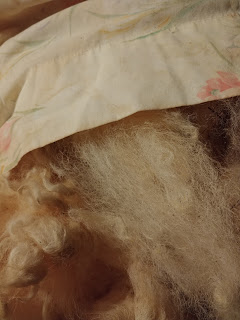I was intrigued by the challenge. It sat in the back of my mind. I saw Ezra a few months later at a training. "Do you have my scarf done?" He asked. "It's starting to get cold!"
I went home that day and dipped into my yarn stash. As a weaver and crocheter, I often have a bit of a skein of yarn left when I finish weaving a shawl or making a hat or...
I came up with the idea of using these little bits of yarn, some only 10 yards long, others hundreds of yards, to make a l-o-n-g, multicolor, scrappy scarf for Ezra.
I crocheted it as we traveled while Shawn drove. As we went north, through corn fields and farmland, I though about the stories of the yarns I was working into this scarf. Some were handspun from our critters fleeces. Some were hand-me-overs from friends who were destashing. Some were bright novelty yarns from gypsy-style shawls I wove. The stories of the yarns wove themselves into the story of our trip. And the concept of story scarves was born.
Ezra loved his scarf as much as I loved creating it. He shared pictures of where he traveled in that scarf. His stories added themselves to the fiber of the first story scarf.
It was a concept that found its home in my heart. Every time I finish a big project, the little bits of left over yarn go into my project bag. That bag travels with me everywhere.
I crochet story scarves at conferences, in hospital waiting rooms, on the plane, and in the passenger seat of the car. I've given them to nurses who went out of their way to care for family members. I've given them to friends who expressed an interest in the project. I've donated them to auctions for scholarships and causes.
My word for 2019 is "Focus" (to me that means "be present where I am and work on the thing that is in front of me at the moment") and to that end, I am focusing story scarves on a cause.
Crafts people across the US are aging. It's hard to make a living with your hands. It's hard to find the time to focus in a craft enough to achieve a mastery of that craft. We have craft masters in more than 20 crafts at the Ozark Folk Center State Park. This year I am focusing on growing our exsisting apprentice program into one that will help young people connect with our craft masters, learn their skills and perpetuate our Ozark tradition of craftsmanship.
To that end, I'm donating 50% of the sales price of each story scarf to the Committee of One Hundred for the Ozark Folk Center. Their craft scholarships have helped create many of the master craft artisans in our park over the last 45 years. We are going to bring that tradition to a new generation.
This story scarf in the picture, crocheted on the plane to Winter Market in Las Vegas, and any others I create this year will be available in my Havencroft Farm etsy store, along with its story. The donation to the Committee will be in the scarf buyers name.
The Story of this Scarf
This story scarf was crocheted on the plane to Las Vegas in January of 2019. We were headed out on a buying trip to Las Vegas Winter Market.
The base yarn in this scarf is the center handspun gray, it is from Cowslip's wool. She is currently our eldest Jacob Sheep ewe. She was born in February of 2003. She is quite the pet and comes out of the retired sheep yard every morning and evening to get her own special grain mix.
The next yarn is a bright red wool. I dyed it to make a hat for an runner friend. I never could get the hat right, and the yarn has been used in several projects. I ought to get back to that. Maybe I'll try some alpaca yarn this time.
The heathered green yarn is from a dear friend who was destashing her very delicious yarns. I let most of the bag go to our Sit & Stitch friends, and to the project basket for the Fiber Arts shop at the Ozark Folk Center, but I liked the feel of this one, and wanted a chance to work with it.
The fall multi colored cotton is from a shawl I wove, as is the blue/green/black thick-thin, the shiny ribbon, and the pale lavendar fuzzy. And there's a light gray alpaca in the mix that Lena used in knitting a pair of socks.



















